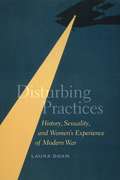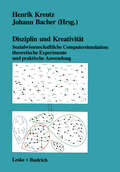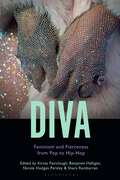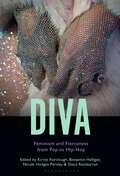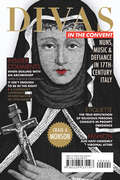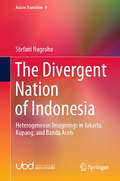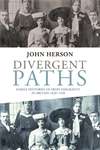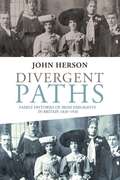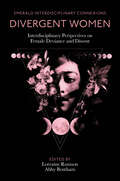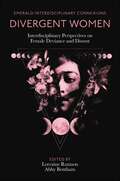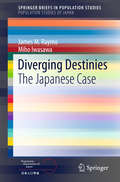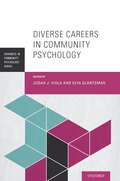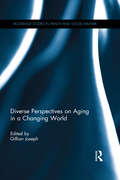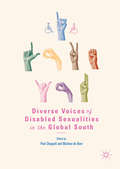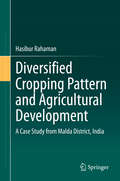- Table View
- List View
Disturbing Practices: History, Sexuality, and Women's Experience of Modern War
by Laura DoanFor decades, the history of sexuality has been a multidisciplinary project serving competing agendas. Lesbian, gay, and queer scholars have produced powerful narratives by tracing the homosexual or queer subject as continuous or discontinuous. Yet organizing historical work around categories of identity as normal or abnormal often obscures how sexual matters were known or talked about in the past. Set against the backdrop of women’s work experiences, friendships, and communities during World War I, Disturbing Practices draws on a substantial body of new archival material to expose the roadblocks still present in current practices and imagine new alternatives. In this landmark book, Laura Doan clarifies the ethical value and political purpose of identity history—and indeed its very capacity to give rise to innovative practices borne of sustained exchange between queer studies and critical history. Disturbing Practices insists on taking seriously the imperative to step outside the logic of identity to address questions as yet unasked about the modern sexual past.
Disturbing Practices: History, Sexuality, and Women's Experience of Modern War
by Laura DoanFor decades, the history of sexuality has been a multidisciplinary project serving competing agendas. Lesbian, gay, and queer scholars have produced powerful narratives by tracing the homosexual or queer subject as continuous or discontinuous. Yet organizing historical work around categories of identity as normal or abnormal often obscures how sexual matters were known or talked about in the past. Set against the backdrop of women’s work experiences, friendships, and communities during World War I, Disturbing Practices draws on a substantial body of new archival material to expose the roadblocks still present in current practices and imagine new alternatives. In this landmark book, Laura Doan clarifies the ethical value and political purpose of identity history—and indeed its very capacity to give rise to innovative practices borne of sustained exchange between queer studies and critical history. Disturbing Practices insists on taking seriously the imperative to step outside the logic of identity to address questions as yet unasked about the modern sexual past.
Disturbing Practices: History, Sexuality, and Women's Experience of Modern War
by Laura DoanFor decades, the history of sexuality has been a multidisciplinary project serving competing agendas. Lesbian, gay, and queer scholars have produced powerful narratives by tracing the homosexual or queer subject as continuous or discontinuous. Yet organizing historical work around categories of identity as normal or abnormal often obscures how sexual matters were known or talked about in the past. Set against the backdrop of women’s work experiences, friendships, and communities during World War I, Disturbing Practices draws on a substantial body of new archival material to expose the roadblocks still present in current practices and imagine new alternatives. In this landmark book, Laura Doan clarifies the ethical value and political purpose of identity history—and indeed its very capacity to give rise to innovative practices borne of sustained exchange between queer studies and critical history. Disturbing Practices insists on taking seriously the imperative to step outside the logic of identity to address questions as yet unasked about the modern sexual past.
Disturbing Practices: History, Sexuality, and Women's Experience of Modern War
by Laura DoanFor decades, the history of sexuality has been a multidisciplinary project serving competing agendas. Lesbian, gay, and queer scholars have produced powerful narratives by tracing the homosexual or queer subject as continuous or discontinuous. Yet organizing historical work around categories of identity as normal or abnormal often obscures how sexual matters were known or talked about in the past. Set against the backdrop of women’s work experiences, friendships, and communities during World War I, Disturbing Practices draws on a substantial body of new archival material to expose the roadblocks still present in current practices and imagine new alternatives. In this landmark book, Laura Doan clarifies the ethical value and political purpose of identity history—and indeed its very capacity to give rise to innovative practices borne of sustained exchange between queer studies and critical history. Disturbing Practices insists on taking seriously the imperative to step outside the logic of identity to address questions as yet unasked about the modern sexual past.
Disturbing Practices: History, Sexuality, and Women's Experience of Modern War
by Laura DoanFor decades, the history of sexuality has been a multidisciplinary project serving competing agendas. Lesbian, gay, and queer scholars have produced powerful narratives by tracing the homosexual or queer subject as continuous or discontinuous. Yet organizing historical work around categories of identity as normal or abnormal often obscures how sexual matters were known or talked about in the past. Set against the backdrop of women’s work experiences, friendships, and communities during World War I, Disturbing Practices draws on a substantial body of new archival material to expose the roadblocks still present in current practices and imagine new alternatives. In this landmark book, Laura Doan clarifies the ethical value and political purpose of identity history—and indeed its very capacity to give rise to innovative practices borne of sustained exchange between queer studies and critical history. Disturbing Practices insists on taking seriously the imperative to step outside the logic of identity to address questions as yet unasked about the modern sexual past.
Disturbing Times: Medieval Pasts, Reimagined Futures
by Vincent W. J. Van Gerven Oei Anna Klosowska Catherine E. KarkovFrom Kehinde Wiley to W.E.B. Du Bois, from Nubia to Cuba, Willie Doherty's terror in ancient landscapes to the violence of institutional Neo-Gothic, Reagan's AIDS policies to Beowulf fanfiction, this richly diverse volume brings together art historians and literature scholars to articulate a more inclusive, intersectional medieval studies. It will be of interest to students working on the diaspora and migration, white settler colonialism and pogroms, Indigenous studies and decolonial methodology, slavery, genocide, and culturecide. The authors confront the often disturbing legacies of medieval studies and its current failures to own up to those, and also analyze fascist, nationalist, colonialist, anti-Semitic, and other ideologies to which the medieval has been and is yoked, collectively formulating concrete ethical choices and aims for future research and teaching. In the face of rising global fascism and related ideological mobilizations, contemporary and past, and of cultural heritage and history as weapons of symbolic and physical oppression, this volume's chapters on Byzantium, Medieval Nubia, Old English, Hebrew, Old French, Occitan, and American and European medievalisms examine how educational institutions, museums, universities, and individuals are shaped by ethics and various ideologies in research, collecting, and teaching.
Disziplin und Kreativität: Sozialwissenschaftliche Computersimulation: theoretische Experimente und praktische Anwendung (Forschungen zur Soziologie und Sozialanthropologie #2)
by Henrik Kreutz Johann BacherDiva: Feminism and Fierceness from Pop to Hip-Hop
by Kirsty Fairclough, Benjamin Halligan, Nicole Hodges Persley and Shara RambarranThe diva – a central figure in the landscape of contemporary popular culture: gossip-generating, scandal-courting, paparazzi-stalked. And yet the diva is at the epicentre of creative endeavours that resonate with contemporary feminist ideas, kick back against diminished social expectations, boldly call-out casual sexism and industry misogyny and, in terms of hip-hop, explores intersectional oppressions and unapologetically celebrates non-white cultural heritages. Diva beats and grooves echo across culture and politics in the West: from the borough to the White House, from arena concerts to nightclubs, from social media to social activism, from #MeToo to Black Lives Matter.Diva: Feminism and Fierceness from Pop to Hip-Hop addresses the diva phenomenon and its origins: its identity politics and LGBTQ+ components; its creativity and interventions in areas of popular culture (music, and beyond); its saints and sinners and controversies old and new; and its oppositions to, and recuperations by, the establishment; and its shifts from third to fourth waves of feminism. This co-edited collection brings together an international array of writers – from new voices to established names. The collection scopes the rise to power of the diva (looking to Mariah Carey, Whitney Houston, Dolly Parton, Grace Jones, and Aaliyah), then turns to contemporary diva figures and their work (with Beyoncé, Amuro Namie, Janelle Monáe, Cardi B, Megan Thee Stallion, Shakira, Jennifer Lopez, and Nicki Minaj), and concludes by considering the presence of the diva in wider cultures, in terms of gallery curation, theatre productions, and stand-up comedy.
Diva: Feminism and Fierceness from Pop to Hip-Hop
The diva – a central figure in the landscape of contemporary popular culture: gossip-generating, scandal-courting, paparazzi-stalked. And yet the diva is at the epicentre of creative endeavours that resonate with contemporary feminist ideas, kick back against diminished social expectations, boldly call-out casual sexism and industry misogyny and, in terms of hip-hop, explores intersectional oppressions and unapologetically celebrates non-white cultural heritages. Diva beats and grooves echo across culture and politics in the West: from the borough to the White House, from arena concerts to nightclubs, from social media to social activism, from #MeToo to Black Lives Matter.Diva: Feminism and Fierceness from Pop to Hip-Hop addresses the diva phenomenon and its origins: its identity politics and LGBTQ+ components; its creativity and interventions in areas of popular culture (music, and beyond); its saints and sinners and controversies old and new; and its oppositions to, and recuperations by, the establishment; and its shifts from third to fourth waves of feminism. This co-edited collection brings together an international array of writers – from new voices to established names. The collection scopes the rise to power of the diva (looking to Mariah Carey, Whitney Houston, Dolly Parton, Grace Jones, and Aaliyah), then turns to contemporary diva figures and their work (with Beyoncé, Amuro Namie, Janelle Monáe, Cardi B, Megan Thee Stallion, Shakira, Jennifer Lopez, and Nicki Minaj), and concludes by considering the presence of the diva in wider cultures, in terms of gallery curation, theatre productions, and stand-up comedy.
Divas in the Convent: Nuns, Music, and Defiance in Seventeenth-Century Italy
by Craig A. MonsonWhen eight-year-old Lucrezia Orsina Vizzana (1590–1662) entered one of the preeminent convents in Bologna in 1598, she had no idea what cloistered life had in store for her. Thanks to clandestine instruction from a local maestro di cappella—and despite the church hierarchy’s vehement opposition to all convent music—Vizzana became the star of the convent, composing works so thoroughly modern and expressive that a recent critic described them as “historical treasures.” But at the very moment when Vizzana’s works appeared in 1623—she would be the only Bolognese nun ever to publish her music—extraordinary troubles beset her and her fellow nuns, as episcopal authorities arrived to investigate anonymous allegations of sisterly improprieties with male members of their order. Craig A. Monson retells the story of Vizzana and the nuns of Santa Cristina to elucidate the role that music played in the lives of these cloistered women. Gifted singers, instrumentalists, and composers, these nuns used music not only to forge links with the community beyond convent walls, but also to challenge and circumvent ecclesiastical authority. Monson explains how the sisters of Santa Cristina—refusing to accept what the church hierarchy called God’s will and what the nuns perceived as a besmirching of their honor—fought back with words and music, and when these proved futile, with bricks, roof tiles, and stones. These women defied one Bolognese archbishop after another, cardinals in Rome, and even the pope himself, until threats of excommunication and abandonment by their families brought them to their knees twenty-five years later. By then, Santa Cristina’s imaginative but frail composer literally had been driven mad by the conflict. Monson’s fascinating narrative relies heavily on the words of its various protagonists, on both sides of the cloister wall, who emerge vividly as imaginative, independent-minded, and not always sympathetic figures. In restoring the musically gifted Lucrezia Orsina Vizzana to history, Monson introduces readers to the full range of captivating characters who played their parts in seventeenth-century convent life.
Divas in the Convent: Nuns, Music, and Defiance in Seventeenth-Century Italy
by Craig A. MonsonWhen eight-year-old Lucrezia Orsina Vizzana (1590–1662) entered one of the preeminent convents in Bologna in 1598, she had no idea what cloistered life had in store for her. Thanks to clandestine instruction from a local maestro di cappella—and despite the church hierarchy’s vehement opposition to all convent music—Vizzana became the star of the convent, composing works so thoroughly modern and expressive that a recent critic described them as “historical treasures.” But at the very moment when Vizzana’s works appeared in 1623—she would be the only Bolognese nun ever to publish her music—extraordinary troubles beset her and her fellow nuns, as episcopal authorities arrived to investigate anonymous allegations of sisterly improprieties with male members of their order. Craig A. Monson retells the story of Vizzana and the nuns of Santa Cristina to elucidate the role that music played in the lives of these cloistered women. Gifted singers, instrumentalists, and composers, these nuns used music not only to forge links with the community beyond convent walls, but also to challenge and circumvent ecclesiastical authority. Monson explains how the sisters of Santa Cristina—refusing to accept what the church hierarchy called God’s will and what the nuns perceived as a besmirching of their honor—fought back with words and music, and when these proved futile, with bricks, roof tiles, and stones. These women defied one Bolognese archbishop after another, cardinals in Rome, and even the pope himself, until threats of excommunication and abandonment by their families brought them to their knees twenty-five years later. By then, Santa Cristina’s imaginative but frail composer literally had been driven mad by the conflict. Monson’s fascinating narrative relies heavily on the words of its various protagonists, on both sides of the cloister wall, who emerge vividly as imaginative, independent-minded, and not always sympathetic figures. In restoring the musically gifted Lucrezia Orsina Vizzana to history, Monson introduces readers to the full range of captivating characters who played their parts in seventeenth-century convent life.
Divas in the Convent: Nuns, Music, and Defiance in Seventeenth-Century Italy
by Craig A. MonsonWhen eight-year-old Lucrezia Orsina Vizzana (1590–1662) entered one of the preeminent convents in Bologna in 1598, she had no idea what cloistered life had in store for her. Thanks to clandestine instruction from a local maestro di cappella—and despite the church hierarchy’s vehement opposition to all convent music—Vizzana became the star of the convent, composing works so thoroughly modern and expressive that a recent critic described them as “historical treasures.” But at the very moment when Vizzana’s works appeared in 1623—she would be the only Bolognese nun ever to publish her music—extraordinary troubles beset her and her fellow nuns, as episcopal authorities arrived to investigate anonymous allegations of sisterly improprieties with male members of their order. Craig A. Monson retells the story of Vizzana and the nuns of Santa Cristina to elucidate the role that music played in the lives of these cloistered women. Gifted singers, instrumentalists, and composers, these nuns used music not only to forge links with the community beyond convent walls, but also to challenge and circumvent ecclesiastical authority. Monson explains how the sisters of Santa Cristina—refusing to accept what the church hierarchy called God’s will and what the nuns perceived as a besmirching of their honor—fought back with words and music, and when these proved futile, with bricks, roof tiles, and stones. These women defied one Bolognese archbishop after another, cardinals in Rome, and even the pope himself, until threats of excommunication and abandonment by their families brought them to their knees twenty-five years later. By then, Santa Cristina’s imaginative but frail composer literally had been driven mad by the conflict. Monson’s fascinating narrative relies heavily on the words of its various protagonists, on both sides of the cloister wall, who emerge vividly as imaginative, independent-minded, and not always sympathetic figures. In restoring the musically gifted Lucrezia Orsina Vizzana to history, Monson introduces readers to the full range of captivating characters who played their parts in seventeenth-century convent life.
Divas in the Convent: Nuns, Music, and Defiance in Seventeenth-Century Italy
by Craig A. MonsonWhen eight-year-old Lucrezia Orsina Vizzana (1590–1662) entered one of the preeminent convents in Bologna in 1598, she had no idea what cloistered life had in store for her. Thanks to clandestine instruction from a local maestro di cappella—and despite the church hierarchy’s vehement opposition to all convent music—Vizzana became the star of the convent, composing works so thoroughly modern and expressive that a recent critic described them as “historical treasures.” But at the very moment when Vizzana’s works appeared in 1623—she would be the only Bolognese nun ever to publish her music—extraordinary troubles beset her and her fellow nuns, as episcopal authorities arrived to investigate anonymous allegations of sisterly improprieties with male members of their order. Craig A. Monson retells the story of Vizzana and the nuns of Santa Cristina to elucidate the role that music played in the lives of these cloistered women. Gifted singers, instrumentalists, and composers, these nuns used music not only to forge links with the community beyond convent walls, but also to challenge and circumvent ecclesiastical authority. Monson explains how the sisters of Santa Cristina—refusing to accept what the church hierarchy called God’s will and what the nuns perceived as a besmirching of their honor—fought back with words and music, and when these proved futile, with bricks, roof tiles, and stones. These women defied one Bolognese archbishop after another, cardinals in Rome, and even the pope himself, until threats of excommunication and abandonment by their families brought them to their knees twenty-five years later. By then, Santa Cristina’s imaginative but frail composer literally had been driven mad by the conflict. Monson’s fascinating narrative relies heavily on the words of its various protagonists, on both sides of the cloister wall, who emerge vividly as imaginative, independent-minded, and not always sympathetic figures. In restoring the musically gifted Lucrezia Orsina Vizzana to history, Monson introduces readers to the full range of captivating characters who played their parts in seventeenth-century convent life.
The Divergent Nation of Indonesia: Heterogeneous Imaginings in Jakarta, Kupang, and Banda Aceh (Asia in Transition #9)
by Stefani NugrohoThis book explores how Indonesia is imagined differently by young people in the three cities of Jakarta, Kupang and Banda Aceh. Throughout the course of Indonesia’s colonial and postcolonial history, Jakarta, the capital, has always occupied a central position, while Kupang in East Nusa Tenggara and Banda Aceh in Nanggroe Aceh Darussalam are located at the peripheries. The book analyses the convergences and divergences in how the country is perceived from these different vantage points, and the implications for Indonesia, also providing a new perspective to the classic and contemporary theories of the nation. By examining the heterogeneity of the imaginings of the nation ‘from below’, it moves away from the tendency to focus on the homogeneity of the nation, found in the classic theories such as Anderson’s and Gellner’s, as well as in more recent theories on every day and banal nationalism. Using the tenets of standpoint theory and Laclau and Mouffe’s theory of hegemony, the nation is acknowledged as an empty signifier that means different things depending on the positionality of the perceiving subject. The work appeals to scholars of nation studies and Asian and Indonesian studies, as well those interested in the empirical grounding of poststructuralist theories.
Divergent paths: Family histories of Irish emigrants in Britain, 1820–1920 (PDF)
by John HersonThis book is unique in adopting a family history approach to Irish immigrants in nineteenth century Britain. It shows that the family was central to the migrants’ lives and identities. The techniques of family and digital history are used for the first time to reveal the paths followed by a representative body of Irish immigrant families, using the town of Stafford in the West Midlands as a case study. The book contains vital evidence about the lives of ordinary families. In the long term many intermarried with the local population, but others moved away and some simply died out. The book investigates what forces determined the paths they followed and why their ultimate fates were so varied. A fascinating picture is revealed of family life and gender relations in nineteenth-century England which will appeal to scholars of Irish history, social history, genealogy and the history of the family.
Divergent paths: Family histories of Irish emigrants in Britain, 1820–1920
by Divergent PathsThis book is unique in adopting a family history approach to Irish immigrants in nineteenth century Britain. It shows that the family was central to the migrants' lives and identities. The techniques of family and digital history are used for the first time to reveal the paths followed by a representative body of Irish immigrant families, using the town of Stafford in the West Midlands as a case study. The book contains vital evidence about the lives of ordinary families. In the long term many intermarried with the local population, but others moved away and some simply died out. The book investigates what forces determined the paths they followed and why their ultimate fates were so varied. A fascinating picture is revealed of family life and gender relations in nineteenth-century England which will appeal to scholars of Irish history, social history, genealogy and the history of the family.
Divergent Women: Interdisciplinary Perspectives on Female Deviance and Dissent (Emerald Interdisciplinary Connexions)
by Lorraine Rumson, Abby BenthamA ‘good woman’ is hard to find. To be ‘good’, after all, women face expectations that are shifting, internally contradictory, emotionally extreme, and prospectively even deadly. To be divergent, on the other hand, is an expansive position, encompassing cackling witches, childfree women, struggling mothers, insecure teenagers, and persecuted innocents. Exploring divergent women from a variety of critical and creative perspectives, this edited collection puts forth a dialogic discussion of how non-conforming women are coded as ‘evil’, and asks, what happens when women choose to be divergent? Delving into reflective and auto-ethnographic perspectives which explore subjective responses to the influence of the representation and treatment of evil women, Divergent Women is ultimately a celebratory reclamation of the concept of feminine transgression. Featuring perspectives from North Korea to Victorian England, from Biblical to digital narratives, this boundary breaking text demonstrates that divergent women have complex inner lives, agencies, and a unique ability to inspire other women to resist social sanctions. Encompassing global perspectives and bringing together artistic and academic work, the authors invite readers to explore the possibilities for divergence that exist under the label of womanhood.
Divergent Women: Interdisciplinary Perspectives on Female Deviance and Dissent (Emerald Interdisciplinary Connexions)
by Lorraine Rumson Abby BenthamA ‘good woman’ is hard to find. To be ‘good’, after all, women face expectations that are shifting, internally contradictory, emotionally extreme, and prospectively even deadly. To be divergent, on the other hand, is an expansive position, encompassing cackling witches, childfree women, struggling mothers, insecure teenagers, and persecuted innocents. Exploring divergent women from a variety of critical and creative perspectives, this edited collection puts forth a dialogic discussion of how non-conforming women are coded as ‘evil’, and asks, what happens when women choose to be divergent? Delving into reflective and auto-ethnographic perspectives which explore subjective responses to the influence of the representation and treatment of evil women, Divergent Women is ultimately a celebratory reclamation of the concept of feminine transgression. Featuring perspectives from North Korea to Victorian England, from Biblical to digital narratives, this boundary breaking text demonstrates that divergent women have complex inner lives, agencies, and a unique ability to inspire other women to resist social sanctions. Encompassing global perspectives and bringing together artistic and academic work, the authors invite readers to explore the possibilities for divergence that exist under the label of womanhood.
Diverging Destinies: The Japanese Case (SpringerBriefs in Population Studies)
by James M. Raymo Miho IwasawaThe overarching objective of this book is to summarize, extend, and update previous research on educational differences in family behavior in Japan. This is the first comprehensive treatment of the subject and the first to evaluate family differentials in Japan in the context of ideas articulated in research on “diverging destinies” and “patterns of disadvantage” as part of the second demographic transition. Much of the previous work in this area has been conducted by the authors (Raymo and Iwasawa), and the longer format of this book allows us to reexamine a wide range of family outcomes using newer data and to provide a thorough and systematic evaluation. The text uses multiple sources of data that cover a period of rapid family change (1970s through 2010s) to describe trends in educational differences in a wide range of family behaviors linked to the well-being of both parents and children. Descriptive analyses provide an overview of period and cohort trends in educational differences in age at first marriage, assortative mating, cohabitation, bridal pregnancy, divorce, remarriage, age at first birth, unintended childbearing, single motherhood, maternal employment, and family-related attitudes. Multivariate analyses provide insights into the processes underlying observed educational differences in family behavior. Patterns of educational differences in family behavior in Japan are evaluated with reference to findings from related research in the United States and other low-fertility Western societies.
Diverse Careers in Community Psychology (Advances in Community Psychology)
by Judah J. Viola and Olya GlantsmanCommunity psychology is a diverse field. Community psychologists may work for the government, for nonprofit foundations, as researchers or teachers in academic settings, at NGOs, as independent consultants, overseas in international development, and more. Despite such professional diversity, very little information has formally been made available to students and practitioners about the range of careers they can pursue when studying community psychology. Diverse Careers in Community Psychology details a range of potential career paths for someone with community psychology or related social science training, describes the different types of careers (e.g., tasks involved, benefits and challenges, salary range, etc.), and outlines steps one can take to develop such a career. The volume is built on three foundations: (1) a career survey of almost 450 respondents, which provides quantitative information about the different types of settings in which individuals with community psychology training might find themselves; (2) more than twenty chapters by contributors who share their personal stories and guidance on how to select, prepare for, find, and succeed in careers similar to theirs; (3) and interviews with community psychologists, further illustrating examples discussed in the authored chapters. This volume provides both a depth and breadth of information about the possible careers available for someone with community psychology or related training.
Diverse Careers in Community Psychology (Advances in Community Psychology)
Community psychology is a diverse field. Community psychologists may work for the government, for nonprofit foundations, as researchers or teachers in academic settings, at NGOs, as independent consultants, overseas in international development, and more. Despite such professional diversity, very little information has formally been made available to students and practitioners about the range of careers they can pursue when studying community psychology. Diverse Careers in Community Psychology details a range of potential career paths for someone with community psychology or related social science training, describes the different types of careers (e.g., tasks involved, benefits and challenges, salary range, etc.), and outlines steps one can take to develop such a career. The volume is built on three foundations: (1) a career survey of almost 450 respondents, which provides quantitative information about the different types of settings in which individuals with community psychology training might find themselves; (2) more than twenty chapters by contributors who share their personal stories and guidance on how to select, prepare for, find, and succeed in careers similar to theirs; (3) and interviews with community psychologists, further illustrating examples discussed in the authored chapters. This volume provides both a depth and breadth of information about the possible careers available for someone with community psychology or related training.
Diverse Perspectives on Aging in a Changing World (Routledge Studies in Health and Social Welfare)
by Gillian JosephFocusing on under-researched aspects of social, economic and political change, this volume offers fresh insights into aging, older people and their families. It combines an international and interdisciplinary approach. Chapters explore the contexts in which family roles, institutional practices, public policies and social and cultural discourses evolve, connecting analyses of aging issues and policy development with sound research practices, as well as previously-ignored gaps in professional practice. Topics covered include politics and policy, health and social care, culture and migration, urban and rural sociology, gender studies, technology and economics. The book will be of particular interest to students and researchers in gerontology, community development, geography and population studies, along with researchers and professionals in physiotherapy, nursing and social work.
Diverse Perspectives on Aging in a Changing World (Routledge Studies in Health and Social Welfare)
by Gillian JosephFocusing on under-researched aspects of social, economic and political change, this volume offers fresh insights into aging, older people and their families. It combines an international and interdisciplinary approach. Chapters explore the contexts in which family roles, institutional practices, public policies and social and cultural discourses evolve, connecting analyses of aging issues and policy development with sound research practices, as well as previously-ignored gaps in professional practice. Topics covered include politics and policy, health and social care, culture and migration, urban and rural sociology, gender studies, technology and economics. The book will be of particular interest to students and researchers in gerontology, community development, geography and population studies, along with researchers and professionals in physiotherapy, nursing and social work.
Diverse Voices of Disabled Sexualities in the Global South
by Paul Chappell Marlene De BeerThis volume aims to critically engage with constructs and experiences of disabled sexualities through Africa, Asia, Latin America and the Caribbean. In doing so, it is hoped that the questions raised, relfections, analyses and arguments will provide readers with a catalyst through which to (re)think disabled sexualities from the perspective of the Global South. What makes this edited volume unique is besides chapters from emerging academics and disability activists who either live or work in the Global South, it also includes personal contributions from disabled people across the Global South. This volume takes a broad perspective on disabled sexualities addressing such areas as gender, race, culture, colonialism, body image, sexual pleasure, sexuality education, sexual access, sexual and reproductive health services, queer sexualities, and sexual rights and justice. The volume will be of interest to international and national organisations for people with disabilities, gender and sexuality researchers, health professionals, social workers, academics and students at all higher education and training institutions interested in disability, gender queer and sexuality studies.
Diversified Cropping Pattern and Agricultural Development: A Case Study from Malda District, India
by Hasibur RahamanThis book examines how crop diversification strategies can help to ensure sustainable agricultural development across different land-size categories, with a focus on Malda District in West Bengal, India. Using Malda as the study area, a region with nearly 4 million people, the book assesses the extent, pattern, factors and future of crop diversification and its contribution to the development of agriculture in Malda and in India as a whole. The work presents data from 1995-2015 concerning changing cropping patterns at various land-size distributions, and analyzes the information over the twenty year period to understand the link between crop diversification and agricultural development, in order to combat major agricultural issues and make suitable policy recommendations at micro (rural) and macro (urban) levels of agricultural planning. The study is a unique contribution to the field of agricultural geography, and will be of use to students and researchers, as well as government organizations, city/community planners and agriculture managers.
